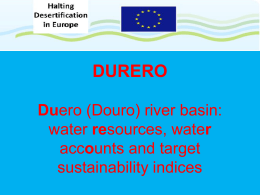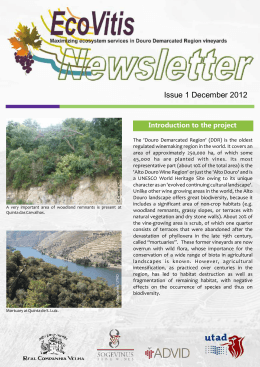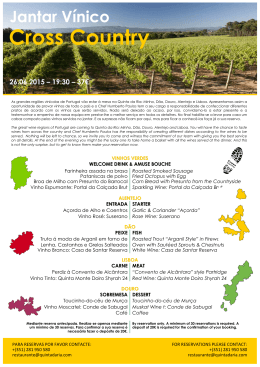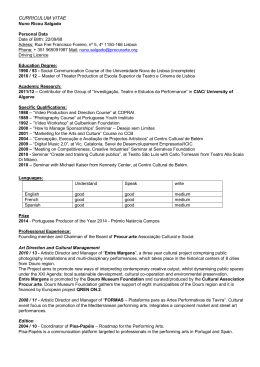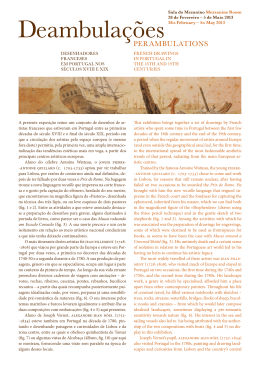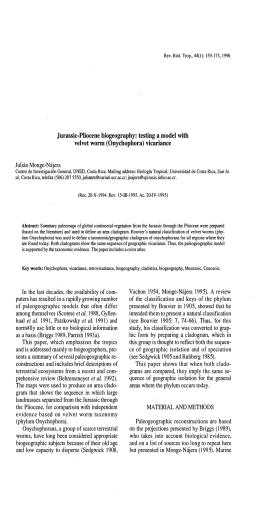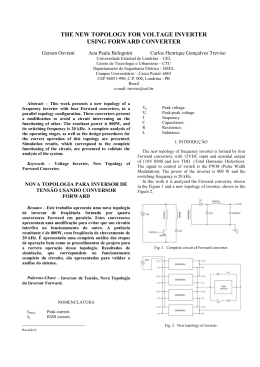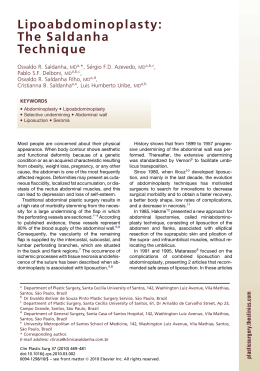Evaluation of the efficacy of first fungicide application on the control of Erysiphe necator and the ascospores release on Douro Region Carmo Val1, Fernando Alves 1, Diana Monteiro 3, António Silvestre2 & Isabel Cortez2 1ADVID 2CITAB, – Associação para o Desenvolvimento da Viticultura no Douro, Quinta de Santa Maria, Apt. 137, 5050-106 Godim, Portugal [email protected],[email protected] Universidade de Trás-os-Montes e Alto Douro, Departamento de Agronomia, Apartado 1013, 5001-801 Vila Real, Portugal [email protected], – Escola Profissional de Desenvolvimento Rural do Rodo, Quinta do Rodo, 5050-092 Godim, Portugal 3EPDRR Methodology Introduction The powdery mildew (Erysiphe necator) is the most important disease which manifests itself more aggressively, in the vineyard in the Douro Region (RDD), Portugal. In RDD, the hibernation occurs mainly in the form of cleistothecia the "drapeaux" are rarely seen, and it is assumed that the first infections were caused by ascospores (Freitas et al, 2005). The cleistothecia are attached on the surface of organs, show a spherical (ostiole lacking), which is initially white in color and evolve to reach the yellow and dark brown to maturation (84-115 mM) (Fig. 1). Each Cleistoteca contains between 4 to 6 asci (50-60 x 25-40 mM) and each contains 4-8 ascospores unicellular, hyaline and ovoid (10-14 x 15-25 mm) (Dubos, 1999). (Fig. 2). The main objective of this work was to evaluate different treatment strategies in early vegetative cycle occurs where the release of ascospores. The plot where the study was conducted is located in Quinta de S. Luíz (Cima Corgo, Douro Demarcated Region). The vineyards of this plot are installed in 2 rows terraces, and the variety is Tinta Roriz (Tempranilho), one of the most frequently planted in this region. At the beginning of March, we put small blades with vaseline with the purpose to catch ascospora (Fig. 3). The blades witches were changed after every time a rainfall episode happens. To evaluate the efficacy of the several chemical strategies of controlling oidium, we define the following protocol (Tab. 1) Fig. 3 – Suporte de lâminas para captura de ascósporos Table 1 - Schedule of treatments for each modality Modalidalities 1T 2T 3T 4T Fig. 1 – Cleistotecas mildew in various states of training Schedule of treatments 28/04/2011 WP - 14/04/2011 WP WP - 12/05/2011 WP IBE IBE Phenology (Bagiollini) F G H+ Dose/ha 4kg/ha 4kg/ha 4kg/ha; 35ml/hl Fig. 2 – Cleistotecas observed under the microscope and its ascospores Results 0,24 a 0 Jul-11 Mar-11 0,60 P NC ab % Oídium a b 4,50 15 0,45 b a b a b 3,00 10 0,30 b 0,08 5 1,50 0,15 0,00 0 0,00 0,00 b 1T 2T 3T 4T 1T 2T 3T 4T 1T 2T 3T 4T 1T 2T b a 3T 4T Fig 5 - Mean values of: - percentages of attack (Oidium%); - kg per vine (P); - number of clusters per vine (NC) and average weight of bunches (PMC) of the modalities 20-05-2011 08-06-2011 12-07-2011 Fig. 6 - Evolution of development of powdery mildew from fruit set until harvest Bibliography ALVES, F. & ALMEIDA, F. (2003) - Contributo para a discussão de estratégias de combate ao oídio da videira Uncinula necator (Schw.) Burr na Região Demarcada do Douro DUBOS, B. (1999) - Les maladies cryptogamiques de la vigne. Champignons parasites des organes herbacés et du bois de la vigne. Editions Féret, Bordeaux. pp: 174. FREITAS, J. & VAL, M. (2005) - Captura de ascósporos de oídio da videira na Região do Douro. Actas VII Encontro Nacional de Protecção Integrada. Instituto Politécnico de Coimbra, Dezembro de 2005: 145-153. T. (ºC) 10 0 Sep-11 20 10 Aug-11 30 20 2-Jun 23-May 5-May 12-May 28-Apr 40 Fig.4 - Dynamic of ascospores release per week and accumulated rainfall and evolution of the climate from March to September (temperature and precipitation) a 0,16 11-Apr 0 31-Mar 0 25-Mar 5 2 50 TMed 30 Jun-11 10 R (mm) 40 May-11 4 P. (mm) 15 18-Mar P. (mm) 6 50 Apr-11 8 6,00 ab PMC a 10 25 20 20 0,32 30 N.º ascospores / week The ascospores release began at least on March 18th and occurred till June 2nd with coincidence among the release picks and the episodes of rain, except on two dates (on May 5th it rained and there was not a strong ascospores release and on May 23rd it did not rain and there was a ascospores pick discharge) (Fig 4) . The efficacy of the first spraying on the development of the disease and its effect was evaluated by determination of the percentage of infected clusters, the yield (kg) per vine (P), the number of clusters per vine (NC) and the average weight of bunches (PMC) on the treatments. During spring and summer of 2011, Oïdium disease had a high expression in Douro region due to the high temperature and precipitation in April and May. The severity of Oïdium was higher (statistically different P<0.05) on the treatment 1T (without sprayings) in comparison with 2T, 3T and 4T (different active compounds and different spraying periods). On 1T the number of clusters/vine, the yield/vine and the weight of bunches/vine was lower in comparison with the other treatments (Fig 5). Among 2T, 3T and 4T there was not significant differences for the parameters evaluated, showing that it was only necessary to start the sprayings near blooming (4T) to control the oidium development . The early treatments don´t show a significantly increase in the control efficacy of the disease, as also stated by Alves et al, 2003. 23-09-2011 23-09-2011
Download

